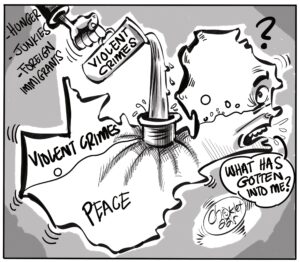Fitch Ratings has downgraded Zambia’s credit rating to ‘B -’ from ‘B’, and maintained the country’s economic outlook to negative, mainly triggered by government’s substantial upward revision in the budget deficit targets.
And Fitch has revised its forecast on Zambia’s general government debt to hit 69 per cent of GDP by the end of this year, up from 60 per cent last year, adding that the debt stock will again rise in 2019.
In a press release issued via Fitch’s Hong Kong bureau, Thursday, Fitch Ratings downgraded Zambia’s long-term foreign-currency issuer default rating (IDR) to ‘B -’ from ‘B’, and maintained a negative economic outlook.
Fitch Ratings director, sovereign ratings, Jermaine Leonard stated that Zambia’s credit rating had been downgraded to ‘B -’, and that the country’s economic outlook remains at negative owing to several key drivers, which are mainly government’s substantial upward revision in the budget deficit targets.
“The downgrade and negative outlook on Zambia’s Long-Term IDRs reflects the substantial upward revision in the government budget deficit targets. Upward revisions to fiscal deficits and government debt have weakened the credibility of the government’s fiscal targets. The government revised the 2018 fiscal deficit target to 7.4 per cent of GDP from the 6.1 per cent contained in the 2018 budget,” Leonard stated.
“The deficit revisions have been the result of the reconciliation of previous disbursements to externally financed projects and of higher debt-servicing costs, both of which reflect broad deficiencies in public financial management and a rapid accumulation of new external debt. The government’s budget targets a reduction in the 2019 fiscal deficit to 6.5 per cent of GDP, from 7.4 per cent in 2018. Fitch believes that the budget targets are optimistic, and forecasts a deficit of 7.5 per cent of GDP in 2018 and 6.9 per cent in 2019. The agency also believes that the risks are tilted to the downside.”
Leonard explained that the key factors that lead to negative rating actions included a rapid deterioration in Zambia’s international reserves, which have plummeted below US $1.8 billion, among others.
“The main factors that could, individually, or collectively, lead to negative rating action include: an inability to access external or domestic sources of financing or evidence of heightened risks in meeting debt-service payments; a failure to narrow the budget deficit and stabilise the government debt/GDP ratio; and deterioration in the external reserves position,” he narrated.
And Leonard explained that Fitch has revised its forecast on Zambia’s general government debt to hit 69 per cent of GDP by the end of this year, up from 60 per cent last year.
He cautioned that the debt stock will again rise next year.
“Fitch now forecasts Zambia’s general government debt to reach 69 per cent of GDP by end-2018, up from 60 per cent at end-2017, and to rise again in 2019. This represents an increase from our previous forecast of a rise to 64 per cent of GDP in 2018 and for government debt to begin falling in 2019. The further expected increase in foreign-currency debt will make Zambia’s debt stock more vulnerable to FX [foreign exchange] volatility and to a rising global interest-rate environment,” explained Leonard.
“Increased external borrowing will also weaken the external position. Reserves were US $1.7 billion in August, 2018, which is down from the US $2.1 billion (or 2.4 months of current external payments (CXP)) at end-2017, as the Bank of Zambia has sought to contain currency depreciation. Fitch forecasts reserves to remain below three months of CXP through 2018 and 2019.”
























